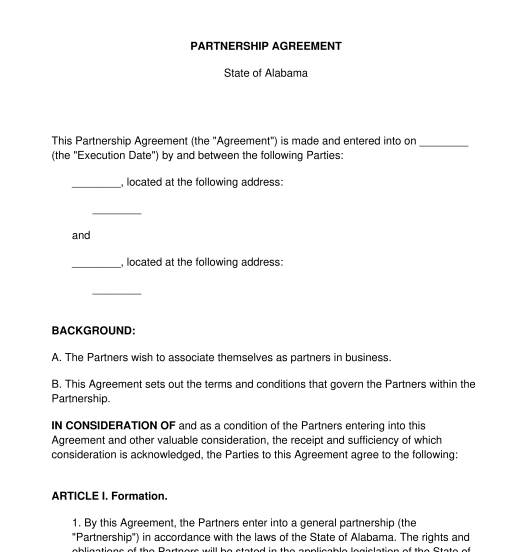 09/26/2025
09/26/2025

Answer a few questions and your document is created automatically.

Your document is ready! You will receive it in Word and PDF formats. You will be able to modify it.




Rating: 4.8 - 2,740 votes
Download a basic template (FREE) Create a customized documentA partnership agreement is a contract between two or more individuals who would like to manage and operate a business together to make a profit. Each partner shares a portion of the partnership's profits and losses, and each partner is personally liable for the debt and obligations of the partnership.
There are two different kinds of partnerships that can be formed. The most common type of partnership is the general partnership. In a general partnership, all business partners have total liability, participate in managing the business, and have the ability to agree to business contracts and loans on behalf of the business. Ownership interests (i.e., how much of the business each partner owns) and profits in a general partnership are usually split evenly between the partners.
The other form of partnership is the limited partnership. Limited partnerships have at least one general partner who controls the business' day to day operations and is personally responsible for the debt of the business, as well as one or more passive partners who are known as limited partners. Limited partners contribute investment money to the business, but have minimal control over daily business decisions and operations. Limited partnerships are most often set up by companies that invest money in other businesses or real estate. In exchange for ceding management power and control, a limited partner's personal liability is solely limited to the amount they invested in the business. The limited partner's investment can be used to pay off partnership debts, but their personal assets cannot be touched to pay off the debts of the business.
When two or more people enter into a business, they form a partnership by default without needing to file any formal paperwork or have a written agreement. By contrast, establishing an LLC involves business owners filing formal articles of organization with their state's LLC filing office, as well as complying with other state filing requirements.
Another major difference between these two business structures is that partners in a partnership are personally liable for any business debts of the partnership. This means that any creditors to whom the partnership owes money may go after all the partner's personal assets. Members of an LLC are not personally liable for the company's debts and liabilities.
No, it is not mandatory to have a partnership agreement to start a legal business partnership. There are no formal requirements to create a general partnership, which means that it is not necessary for anything to be put down in writing for the partnership to form.
Though there is no requirement for a written partnership agreement, it is highly advisable that one be created. This document acts as a critical foundational document for running a new business and serves to set the business up for success by ensuring clear communication and defined responsibilities for all the partners.
A capital contribution is the money, services, property, and other resources that are initially contributed to the partnership by each of the partners.
The ownership interest is the percent of the partnership's assets, earnings, and other value owned by each partner.
A valid partnership agreement must contain at least the following mandatory clauses:
Before creating and filing a partnership agreement, the partners should select and register the name of the partnership. The name of the business should be unique and comply with any specific requirements in the jurisdiction where the partnership is being registered. The partners should check with the city or county clerk's office to see whether the desired name is already on the list of businesses operating within the jurisdiction.
The primary requirement to enter into a partnership agreement is that the person have the legal capacity to enter into a contract. This means that the person is of legal age, 18 years old or older in most jurisdictions, and has the mental capacity to understand the contract they are signing. Both individual people and legal entities, such as corporations, trusts and estates, LLCs, and other partnerships, can enter into a partnership agreement. Foreign nationals may enter into a partnership agreement as long as they have the appropriate immigration status to allow them to work and engage in business activities in the United States.
Minors under the age of 18 years old may not enter into a partnership unless they have been emancipated by a court.
Individuals or entities who are currently engaged in bankruptcy proceedings are often restricted from entering into new partnerships.
Once this document is complete, all the partners should sign and date the document. The document does not need to be notarized or witnessed to be legally binding.
Creating a partnership agreement is just the first step in forming a partnership. After the agreement has been drafted, to register a partnership, the partners must file additional documents depending on the state in which they are located. To learn more, please consult the appropriate state department website in the state where the business is located to determine any additional requirements.
Partnership Agreements are subject to the laws of individual states. There is no one federal law covering the requirements for a Partnership Agreement. This is because each individual state governs the businesses formed within that state.
You fill out a form. The document is created before your eyes as you respond to the questions.
At the end, you receive it in Word and PDF formats. You can modify it and reuse it.
Guides to help you
Partnership Agreement - FREE - Template - Word and PDF
Country: United States